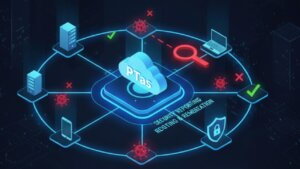In an era where cyber threats are a growing concern for individuals and organizations alike, ethical hacking has emerged as a critical practice to safeguard digital assets. But what exactly is ethical hacking, and why is it important?
Table of Contents
Understanding Ethical Hacking

Ethical hacking, also known as penetration testing or white-hat hacking, involves the authorized probing of computer systems, networks, or applications to identify vulnerabilities. Ethical hackers use the same tools and techniques as malicious hackers but operate with permission and a legal framework to strengthen security.
Unlike cybercriminals, ethical hackers aim to prevent harm. By simulating potential attacks, they provide organizations with insights into security gaps, enabling proactive defense measures.
Types of Hackers
To understand ethical hacking, it’s essential to distinguish between the types of hackers:
White Hat Hackers: These are ethical hackers who work to improve security. They are often certified professionals hired by organizations.
Black Hat Hackers: These individuals exploit vulnerabilities for malicious purposes, such as stealing data or causing disruptions.
Gray Hat Hackers: Operating in a moral and legal gray area, these hackers find vulnerabilities without permission but may inform the affected organization.
Why is Ethical Hacking Important?
Ethical hacking plays a pivotal role in modern cybersecurity. Here are some reasons why it’s essential:
Preventing Cyber Attacks: By identifying vulnerabilities before malicious hackers do, ethical hacking helps thwart potential attacks.
Protecting Sensitive Data: Organizations can secure personal, financial, and confidential data through proactive vulnerability assessments.
Compliance and Regulations: Many industries require regular security audits, and ethical hacking helps meet these compliance standards.
Building Trust: Demonstrating a commitment to security enhances trust among customers and stakeholders.
The Ethical Hacking Process

Ethical hacking follows a systematic approach to identify and address vulnerabilities. The key steps include:
Reconnaissance: Gathering information about the target system or network, such as IP addresses, domain details, and open ports.
Scanning: Using tools like Nmap or Nessus to identify active hosts, open ports, and vulnerabilities.
Gaining Access: Attempting to exploit identified vulnerabilities to assess the potential impact of an attack.
Maintaining Access: Simulating scenarios where an attacker maintains unauthorized access to evaluate long-term risks.
Analysis and Reporting: Documenting findings, outlining potential risks, and recommending remediation strategies.
Tools Used in Ethical Hacking
Ethical hackers leverage various tools to uncover vulnerabilities. Some popular tools include:
Nmap: Network scanning and reconnaissance.
Metasploit: Exploitation framework for testing vulnerabilities.
Wireshark: Network protocol analyzer for packet inspection.
Burp Suite: Web application security testing.
Kali Linux: A penetration testing platform with pre-installed tools.
Ethical Hacking Certifications
Becoming an ethical hacker typically requires certifications that validate skills and knowledge. Prominent certifications include:
Certified Ethical Hacker (CEH): Offered by EC-Council, this certification covers ethical hacking fundamentals and advanced concepts.
Offensive Security Certified Professional (OSCP): Focuses on hands-on penetration testing skills.
CompTIA PenTest+: A comprehensive certification covering vulnerability assessment and management.
GIAC Penetration Tester (GPEN): Offered by SANS Institute, this certification focuses on real-world penetration testing techniques.
Challenges in Ethical Hacking
While ethical hacking offers immense benefits, it also comes with challenges:
Constantly Evolving Threats: Cyber threats evolve rapidly, requiring ethical hackers to stay updated on the latest attack methods.
Legal and Ethical Boundaries: Navigating the fine line between ethical and unethical practices requires clear guidelines.
Resource Constraints: Limited time and budget can restrict the depth of security assessments.
Complex Environments: Modern IT ecosystems often involve diverse technologies, making vulnerability assessments more challenging.
The Future of Ethical Hacking
As technology advances, ethical hacking will remain a cornerstone of cybersecurity. Emerging trends that will shape its future include:
AI and Machine Learning: These technologies will enhance threat detection and automate vulnerability assessments.
Cloud Security: With more organizations adopting cloud computing, ethical hackers will focus on securing cloud environments.
IoT Security: As Internet of Things (IoT) devices proliferate, ensuring their security will become critical.
Quantum Computing: The advent of quantum technology will present new challenges and opportunities for ethical hackers.
Conclusion
Ethical hacking is more than just a cybersecurity practice; it’s a proactive approach to safeguarding the digital world. By identifying and addressing vulnerabilities, ethical hackers play a vital role in protecting individuals, organizations, and governments from cyber threats. As the digital landscape continues to evolve, the importance of ethical hacking will only grow, making it an indispensable component of modern cybersecurity.
Why Businesses Trust SecureMyOrg for Comprehensive Network Security
At SecureMyOrg, we uncover and fix all possible security vulnerabilities of mobile and web, while providing solutions to mitigate risks. We are trusted by renowned companies like Yahoo, Gojek and Rippling, and with 100% client satisfaction, you’re in safe hands!







Some of the things people reach out to us for –
- Building their cybersecurity program from scratch – setting up cloud security using cost-effective tools, SIEM for alert monitoring, building policies for the company
- Vulnerability Assessment and Penetration Testing ( VAPT ) – We have certified professionals, with certifications like OSCP, CREST – CPSA & CRT, CKA and CKS
- DevSecOps consulting
- Red Teaming activity
- Regular security audits, before product release
- Full time security engineers.
Relevant Posts

Top Cybersecurity Threats Facing Businesses In 2026
Businesses entering 2026 face a security landscape that is more complex, more interconnected, and far less forgiving than in previous years. Cybersecurity threats no longer

Top 5 Security Weaknesses Cloud-Native Apps Commonly Ignore
Cloud-native applications promise speed, flexibility, and scalability. Teams ship features faster, infrastructure adapts automatically, and operational overhead drops. Yet many organizations discover later that security

Why Weak Serverless Application Security Puts Your Business at Risk
Weak security in serverless environments often goes unnoticed until it leads to real damage. Misconfigured triggers, broad permissions, and poor visibility can expose sensitive data and disrupt business operations. Understanding where the risks appear is the first step toward building safer, more reliable serverless applications.

What Is Penetration Testing as a Service?
Penetration testing as a service (PTaaS) lets experts simulate real attacks to uncover vulnerabilities before hackers do. This guide explains the process, benefits, and costs, helping businesses strengthen defenses with predictable, ongoing security checks.

How To Inspect Encrypted Traffic Without Breaking Privacy
Network administrators face a challenge: securing systems while respecting privacy. This guide explains how to inspect encrypted traffic without breaking privacy using metadata, anomaly detection, and machine learning ensuring visibility, compliance, and trust.

How to Audit Infrastructure as Code (IaC) for Security Vulnerabilities
Discover how to audit Infrastructure as Code (IaC) for security vulnerabilities with this practical guide. Learn to scan IaC files using tools like Checkov, fix issues like exposed resources, and integrate audits into CI/CD pipelines. Protect your cloud systems from misconfigurations and ensure compliance with clear, actionable steps.
